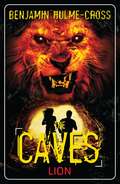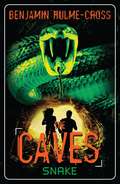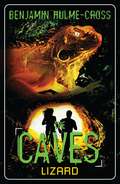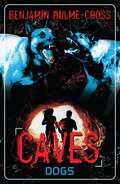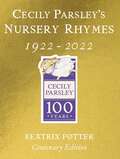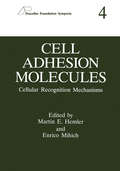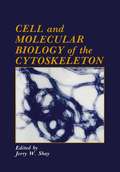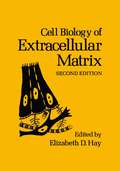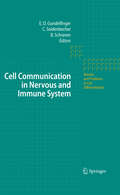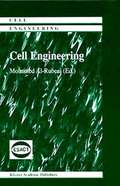- Table View
- List View
The Caves: The Caves 5 (The Caves)
by Benjamin Hulme-CrossIn the future, convicted Teens have a choice. Life in prison, or taking their chance in The Caves. Two Teens are dropped onto a remote island, along with a cyborg monster. If they kill the cyborg, they go free. If they fail, they die. Zak, the wild boy of the island, watches the Teens. Sometimes he helps them. Sometimes he doesn't.Highly readable, exciting books that take the struggle out of reading, Caves encourages and supports reading practice by providing gripping, age-appropriate stories for struggling and reluctant readers or those with English as an additional language aged 12+, at a manageable length (32 pages) and reading age (6+). This series can be read in any order. Produced in association with reading experts at Catch Up, a charity which aims to address underachievement caused by literacy and numeracy difficulties.Book band: PurpleIdeal for ages: 12+Reading age: 6
The Caves: The Caves 6 (The Caves #6)
by Benjamin Hulme-CrossIn the future, convicted Teens have a choice. Life in prison, or taking their chance in The Caves. Two Teens are dropped onto a remote island, along with a cyborg monster. If they kill the cyborg, they go free. If they fail, they die. Zak, the wild boy of the island, watches the Teens. Sometimes he helps them. Sometimes he doesn't.Highly readable, exciting books that take the struggle out of reading, Caves encourages and supports reading practice by providing gripping, age-appropriate stories for struggling and reluctant readers or those with English as an additional language aged 12+, at a manageable length (32 pages) and reading level (6+). This series can be read in any order. Produced in association with reading experts at Catch Up, a charity which aims to address underachievement caused by literacy and numeracy difficulties.Book band: PurpleIdeal for ages: 12+Reading age: 6
The Caves: The Caves 1 (The Caves)
by Benjamin Hulme-CrossIn the future, convicted Teens have a choice. Life in prison, or taking their chance in The Caves. Two Teens are dropped onto a remote island, along with a cyborg monster. If they kill the cyborg, they go free. If they fail, they die. Zak, the wild boy of the island, watches the Teens. Sometimes he helps them. Sometimes he doesn't.Highly readable, exciting books that take the struggle out of reading, Caves encourages and supports reading practice by providing gripping, age-appropriate stories for struggling and reluctant readers or those with English as an additional language aged 12+, at a manageable length (32 pages) and reading age (6+). This series can be read in any order. Produced in association with reading experts at CatchUp, a charity which aims to address underachievement caused by literacy and numeracy difficulties.Book band: PurpleIdeal for ages: 12+Reading age: 6
The Caves: The Caves 2 (The Caves #2)
by Benjamin Hulme-CrossIn the future, convicted Teens have a choice. Life in prison, or taking their chance in The Caves. Two Teens are dropped onto a remote island, along with a cyborg monster. If they kill the cyborg, they go free. If they fail, they die. Zak, the wild boy of the island, watches the Teens. Sometimes he helps them. Sometimes he doesn't.Highly readable, exciting books that take the struggle out of reading, Caves encourages and supports reading practice by providing gripping, age-appropriate stories for struggling and reluctant readers or those with English as an additional language aged 12+, at a manageable length (32 pages) and reading age (6+). This series can be read in any order. Produced in association with reading experts at Catch Up, a charity which aims to address underachievement caused by literacy and numeracy difficulties.Book band: PurpleIdeal for age: 12+Reading age: 6
The Cayman Islands: Natural History and Biogeography (Monographiae Biologicae #71)
by M. A. Brunt J. E. DaviesIn the course of the last century a considerable amount of scientific work has been carried out in the Cayman Islands. The results of this (outlined in Chapter 1) are widely distributed in unpublished reports, university theses, various scientific publications and books, many of these sources being difficult to find and some now unobtainable. The purpose of this book, therefore, is to bring all this scattered information together and to present a coherent account of the biogeography and ecology of the Islands, as an easily available reference source and as a foundation on which future work can be based.
Cecily Parsley's Nursery Rhymes (The Psammead Ser.)
by Beatrix PotterThis original, authorised version has been lovingly recreated electronically for the first time, with reproductions of Potter's unmistakeable artwork optimised for use on colour devices such as the iPad. Cecily Parsley's Nursery Rhymes is a sequel to Beatrix Potter's first rhyme collection, Appley Dapply's Nursery Rhymes. Like the previous book it contains material she had produced and collected over a period of many years. the Cecily Parsley sequence of illustrations, for example, were first made into a little booklet twenty-five years earlier, in 1897.Cecily Parsley's Nursery Rhymes is the last of Beatrix Potter's series of 23 little books, the titles of which are as follows:1 The Tale of Peter Rabbit2 The Tale of Squirrel Nutkin3 The Tailor of Gloucester4 The Tale of Benjamin Bunny5 The Tale of Two Bad Mice6 The Tale of Mrs. Tiggy-Winkle7 The Tale of Mr. Jeremy Fisher8 The Tale of Tom Kitten9 The Tale of Jemima Puddle-Duck10 The Tale of the Flopsy Bunnies11 The Tale of Mrs. Tittlemouse12 The Tale of Timmy Tiptoes13 The Tale of Johnny Town-Mouse 14 The Tale of Mr. Tod15 The Tale of Pigling Bland16 The Tale of Samuel Whiskers17 The Tale of The Pie and the Patty-Pan18 The Tale of Ginger and Pickles19 The Tale of Little Pig Robinson20 The Story of a Fierce Bad Rabbit21 The Story of Miss Moppet22 Appley Dapply's Nursery Rhymes23 Cecily Parsley's Nursery Rhymes
Celebrating the Seasons with the Yorkshire Shepherdess: Farming, Family and Delicious Recipes to Share
by Amanda OwenA stunning book from Amanda Owen - shepherdess, wife, mother of nine children, bestselling author and star of C5’s Our Yorkshire Farm - that brings her world to life in glorious colour.In Celebrating the Seasons, Amanda shares funny and charming stories about life with her family and their many four-legged charges and describes their activities at Ravenseat, from lambing and shearing to haymaking and feeding the flock in midwinter. Her gorgeous photographs showcase the famous Swaledale landscape she writes about, from the sweeping moors to rare wildflowers and the elusive hares glimpsed in the field.She lives in tune with nature and Amanda's attitude to food is the same. She believes in buying good, seasonal ingredients when it comes to feeding her family and includes her favourite recipes here, from wild garlic lamb with hasselback roast potatoes to rhubarb and custard crumble cake and Yorkshire curd tart. As inspirational as Amanda herself, this book is a beautiful keepsake that will delight everyone who has followed her adventures so far.
Celebrating the Seasons with the Yorkshire Shepherdess: Farming, Family and Delicious Recipes to Share
by Amanda OwenThe Sunday Times bestseller, now in paperback with new material covering another twelve months on the farm with the Yorkshire Shepherdess.In Celebrating the Seasons, Amanda Owen shares funny and charming stories about life with her family and their many four-legged charges and describes their activities at Ravenseat, from lambing and shearing in spring to haymaking in summer and feeding the flock in midwinter. She vividly evokes the famous Swaledale landscape, from the sweeping moors to rare wildflowers and elusive hares glimpsed in the field.Amanda lives in tune with nature, and her attitude to food is the same. She believes in using good, seasonal ingredients when it comes to feeding her family, and includes some of her favourite recipes here, from wild garlic lamb with hasselback potatoes to rhubarb and custard crumble cake and Yorkshire curd tart. The book also includes her Dalesman columns, published in book form for the first time and giving new insights into her life.As inspirational as Amanda herself, this book will delight everyone who has followed her adventures so far.
Cell Activation and Apoptosis in HIV Infection: Implications for Pathogenesis and Therapy (Advances in Experimental Medicine and Biology #374)
by Jean-Marie Andrieu Wei LuIn the past decade, the global efforts in the control of HIV disease were basically concentrated on the search for anti-retroviral agents. So far, anti-HIV therapies have been shown to be disappointing because of rapid development of drug-resistant mutant variants. Despite this drawback in the therapeutic fight against HIV infection, antiviral research should be actively pursued. However, failure of antiviral therapy indicates that other avenues of research should be rapidly explored with the same energy. In this setting, striking advances have been recently made in the dissection and understanding of the viro-immunological processes governing the progressive destruction of lymphoid organs associated with AIDS develop ment, and HIV-induced activation and apoptosis have been identified as key phenomena of the immune system destruction. This book assembles the most recent advances on basic and clinical aspects ofT-cell activationiapoptosis in HIV infection and their implications for immunotherapy. These data were presented at an international symposium held on July 11-12, 1994, in Paris. The book is partitioned into 21 chapters covering four comprehensive fields: 1) T-celllmacrophage activation and HIV infection; 2) Apoptosis and viropathogenesis of HI V disease; 3) Apop tosis and immunopathogenesis ofHIV disease; 4) Mediators ofT-cell activationiapoptosis and therapeutic applications. We hope that this book will assist the readers in understanding recent advances in the viro-immunopathogenesis of HI V disease as well as the rationales for potential immune cell-targeted therapeutic interventions.
Cell Adhesion Molecules: Cellular Recognition Mechanisms (Pezcoller Foundation Symposia #4)
by Martin E. Hemler and Enrico MihichThe Fourth Annual Pezcoller Symposium entitled Adhesion Molecules: Cellular Recognition Mechanisms was held in Rovereto, Italy, June 24-26, 1992 and was focussed on the detailed mechanisms whereby cells utilize certain integral membrane proteins to perceive their surrounding environment and interact with it. With timely presentations and stimulating discussions this Symposium addressed the genetics and biochemistry of adhesion molecules, the regulation of their functions and their role in cancer and the immune system. Emphasis was given to adhesion proteins in the integrin family because of the widespread distribution of this group of molecules and its important role in essentially all eukaryotic biological systems. The regulation of integrin genes and their expression are discussed in detail, as are specific aspects of the genetics of fibronectin. The molecular basis for the regulation of certain integrins, the function of these proteins in determining cell adhesion, and the consequences of this adhesion for the function of the cells involved are discussed. The role of certain integrins in stimulating signal transduction, the essential involvement of integrins in conditioning the function of T and NK cells function, the heterogeneity of integrins and its biological consequences, and the role of cell adhesion molecules in tumor cells invasion and metastases are all extensively analyzed. New information was presented on the role of CD44 and splice variants in normal differentiation and tumor progression.
Cell and Model Membrane Interactions
by S. OhkiMembrane interaction is a large research area involving various disciplines. A symposium entitled "Cell and Model Membrane Interactions" which took place in Boston, MA during the 155th American Chemical Society Meeting, April 25, 1990, focused on membrane adhesion and fusion. The topics were explored in studies involving lipids, virus envelopes and cell membranes. Especially discussed, were the roles of polymers, lipids, and proteins on these membrane interactions. Fusion of membrane is an important molecular event which plays a pivotal role in many dynamic cellular processes, such as exocytosis, endocytosis, membrane genesis, viral infection processes, etc. The process includes adhesion of the mem branes, fusion, and finally reorganization of the components of the two membranes. The basic notion shared during the symposium was that membrane hydro phobicity, especially local membrane hydrophobicity is one of the important factors contributing to membrane fusion. Most of the papers are collected here and they are arranged approximately in the same order as they were presented at the sympo sium. These papers are the most up-to-date and representative work at the forefront in each membrane interaction field. I sincerely hope the reader will gain further understanding on membrane interactions especially, membrane and vesicle fusion phenomena through this symposium proceedings volume.
Cell and Molecular Biology of the Uterus (Advances in Experimental Medicine and Biology #230)
by W. LeavittThe papers in this volume were presented at the Symposium on Cell Biology of the Uterus held December 12, 1986, on the NIH campus, Bethesda, MD. This was the first of a series of meetings that will be held in con junction with the annual meeting of the American Society for Cell Biology. The uterus is now recognized as an extremely complex organ whose nor mal function is orchestrated by a delicate procession of cellular and molecular events that investigators are beginning to unravel for the first time. Powerful new analytical methods and the tools of molecular biology are now providing exciting breakthroughs in our basic understanding of uterine structure and function. Thus, the program of this meeting was or ganized to cover recent developments in uterine cell biology including the mechanism of hormone action, control of gene expression by nuclear acceptor sites and nuclear receptors, role of growth factors, endometrial cell kine tics during the menstrual cycle, regulation of specific protein synthesis and secretion, decidual cell function, and the role of early pregnancy pro teins. The material presented in this volume is concerned not only with how hormones and growth factors prepare the endometrium for implantation of the blastocyst, but it also details the recent characterization and identification of specific marker proteins secreted in response to hormone action and early pregnancy.
Cell Biology of Extracellular Matrix: Second Edition
by E. D. HayIn the ten-year interval since the first edition of this volume went to press, our knowledge of extracellular matrix (ECM) function and structure has enor mously increased. Extracellular matrix and cell-matrix interaction are now routine topics in the meetings and annual reviews sponsored by cell biology societies. Research in molecular biology has so advanced the number of known matrix molecules and the topic of gene structure and regulation that we won dered how best to incorporate the new material. For example, we deliberated over the inclusion of chapters on molecular genetics. We decided that with judicious editing we could present the recent findings in molecular biology within the same cell biology framework that was used for the first edition, using three broad headings: what is extracellular matrix, how is it made, and what does it do for cells? Maintaining control over the review of literature on the subject of ECM was not always an easy task, but we felt it was essential to production of a highly readable volume, one compact enough to serve the the student as an introduction and the investigator as a quick update on graduate the important recent discoveries. The first edition of this volume enjoyed con hope the reader finds this edition equally useful. siderable success; we D. Hay Elizabeth vii Contents Introductory Remarks 1 Elizabeth D. Hay PART I. WHAT IS EXTRACELLULAR MATRIX? Chapter 1 Collagen T. F. Linsenmayer 1. Introduction . . . . . . . . . . . . . . . . . . . . . . . . . . . . . . . . . . . . . . . . . . . . . . . . . . 7 2. The Collagen Molecule . . . . . . . . . . . . . . . . . . . . . . . . . . . . . . . . . . . . . . . . 8 2. 1. Triple-Helical Domain(s) . . . . . . . . . . . . . . . . . . . . . . . . . . . . . . . . . .
The Cell Biology of Sponges
by T.L. SimpsonModem biology owes much to the study of favorable model systems which fa cilitates the realization of critical experiments and results in the introduction of new concepts. Examples of such systems are numerous and studies of them are regularly recognized by the scientific community. The 1983 Nobel Prize in Med icine and Physiology is a magnificent example in which com plants served as the experimental model. In a manner somewhat more modest, other biological systems have attracted recognition due to their critical phylogenetic position, or indeed because of their uniqueness which distinguishes them from all other organisms. Assuredly, among the whole assemblage ofliving organisms, sponges stand out as worthy of interest by scientists: they are simultaneously models, an important group in evolution, and animals unlike others. As early as the beginning of this century, sponges appeared as exceptional models for the study of phenomena of cell recognition. Innumerable works have been dedicated to understanding the mechanisms which assure the reaggregation of dissociated cells and the reconstitution of a functional individual. Today, re search on these phenomena is at the ultimate, molecular level. Through an as semblage of characteristics the sponges are, based upon all available evidence, the most primitive Metazoans. Their tissues-perhaps one can say their cell groups-are loosely assembled (they possess no tight or gap junctions), cell dif ferentiation appears highly labile, and they do not develop any true organs. But, they are most certainly Metazoans.
Cell-Cell Interactions in the Release of Inflammatory Mediators: Eicosanoids, Cytokines, and Adhesion (Advances in Experimental Medicine and Biology #314)
by Patrick Y-K Wong Charles N. SerhanThis volume constitutes. in part. the proceedings of the symposium on "Cell-Cell Interaction and Release of Inflammatory Mediators" organized by Drs. Patrick Y-K Wong and Charles N. Serhan and presented at the FASEB meeting in Washington. D.C. in April. 1990. It contains chapters by the symposium speakers as well as contributions from investigators in this field. Readers will find exciting advances in this volume. which contains chapters dedicated to state-of-the-art knowledge in the field of Cell-Cell Interaction and the functions of released mediators in inflammatory diseases. This book includes "cutting edge" investigations on transcellular eicosanoid biosynthesis. cytokines. PAF, and adhesion as well as interactions of inflammatory cells with endothe 1 i um. 1 ung • and kidney. A 1 so. the contro 1 and regu 1 at ion of renal function by lipid mediators generated during cell-cell i nteracti ons between rena 1 mesangi a 1 cells and 1 eukocytes has generated insight into the cell biology and regulatory role of these mediators in the kidney. Moreover. the relationship between these areas is discussed in sequelae of both asthmatic and renal diseases. We hope that some of the enthusiasm and excitement present in this research are also evident here and that this volume will serve as a reference for researchers. teachers. and students to survey thi s rapidly growing field.
Cell Communication in Nervous and Immune System (Results and Problems in Cell Differentiation #43)
by Eckart D. Gundelfinger Constanze Seidenbecher Burkhart SchravenThis collection of reviews contains contributions by internationally recognized immunologists and molecular and cellular neurobiologists. Uniquely, it puts side by side cellular communication devices and signaling mechanisms in the immune and nervous systems and discusses mechanisms of interaction between the two systems, the significance of which has only recently been fully appreciated.
Cell Culture Engineering IV: Improvements of Human Health (Current Applications of Cell Culture Engineering #1)
by B. C. BucklandCell Culture Engineering IV, Improvements of Human Health covers the latest approaches to improving the cell host through improved understanding of the molecular biology, the development of novel vaccines, approaches to bioreactor design and operation, monitoring techniques in process control and quality related topics. The work was carefully put together as one result of the Cell Culture Engineering IV Meeting held in San Diego, U.S.A. in 1994, however, the book may not be perceived as a proceedings volume - the criteria of the book series apply. For cell biologists, biochemists, molecular biologists, immunologists and other disciplines related to cell culture engineering, working in the academic environment, as well as in (biotechnology or pharmaceutical) industry.
Cell Culture Engineering VI (Current Applications of Cell Culture Engineering #3)
by Alison J. Mastrangelo Frank W. R.Chaplen RobArathoon Jeffrey J. Chalmers Michael J. BetenbaughThe latest edition in this continuing series includes the newest advances in the rapidly evolving field of animal cell culture, genetic manipulations for heterologous gene expression, cell line enhancements, improved bioreactor designs and separations, gene therapy manufacturing, tissue engineering, anti-apoptosis strategies and cell cycle research. The contents include new research articles as well as critical reviews on emerging topics such as viral and viral-like agent contamination of animal cell culture components. These papers were carefully selected from contributions by leading academic and industrial experts in the biotechnology community at the recent Cell Culture Engineering VI Meeting in San Diego, USA, 1998. However, the book is not merely a proceedings. Audience: Biochemical engineers, cell biologists, biochemists, molecular biologists, immunologists and other disciplines related to cell culture engineering, working in the academic environment and the biotechnology or pharmaceutical industry.
Cell Culture Methods for In Vitro Toxicology
by Glyn N. Stacey Alan Doyle Margherita FerroCell Culture Methods for in vitro Toxicology introduces the reader to a range of techniques involved in the use of in vitro cell culture in toxicological studies. It deals with major cell types studied in the field of toxicology and will be useful for anyone wishing to start work with animal cell cultures or to refresh their knowledge relating to in vitro cell models. Fundamental chapters deal with the general biology of cytotoxicity and cell immortalisation these are key issues for in vitro systems addressing the `3Rs' principle. Up-to-date overviews deal with the use of cells from liver, brain and intestine. In addition, biochemical analysis of cell responses, biotransformation pathways in cells and recombinant approaches to the early detection of cell stress are also covered in detail. Prominent features of in vitro technologies also include regulation, biosafety and standardisation. Dedicated chapters deal with these issues in a practical way in order to lead the reader to the right source of information. This book provides an up-to-date, informative and practical review of cell culture methods for in vitro toxicology. It will be of equal benefit to students and experienced toxicologists with little experience of in vitro cell culture.
The Cell Cycle: Regulators, Targets, and Clinical Applications (Gwumc Department of Biochemistry and Molecular Biology Annual Spring Symposia)
by Valerie W. HuInterest in the cell cycle has grown explosively in recent years as a result of the identification of key cell cycle regulators and their substrates. Aside from enhancing our understanding of normal cellular growth controls, this new knowledge has also becn valuable in elucidating mechanisms of growth deregulation which occur in diseased states, such as cancer and, in some instances, viral or parasitic infections. The Thirteenth Washington International Spring Symposium was organized with the intention of bringing together scientists working on different aspects of the cell cycle. Scientific topics presented ranged from molecular regulators and effectors to mitosis specific changes in cell architecture to the role of the cell cycle in development and disease. The goal of this gathering was to help formulate a more comprehensive and integrated picture of events driving and being driven by the cell cycle, as well as to evaluate the possibilities for clinical application of this knowledge. This symposium, held in Washington, D.C. from May 10-14, 1993, was attended by more than 400 scientists from 20 countries, including many of the scientific leaders in this field. This volume contains most of the papers presented at the seven plenary sessions in addition to selected contributions from a total of nine special oral and poster sessions.
Cell Cycle - Materials and Methods (Springer Lab Manuals)
by Michele PaganoDuring their lifetime, especially when growing and dividing, cells go through various steps of the cell cycle. Knowledge of the individual steps of the cell cycle will help us understand the development of a variety of diseases better, including cancer, and also to design new drugs against it. New techniques for studying the molecular basis of these processes have recently been developed and are described in detail in this manual.A glossary helps the reader to cope with the complex cell cycle terminology.
Cell-Cycle Mechanisms and Neuronal Cell Death (Neuroscience Intelligence Unit)
by Agata Copani Ferdinando NicolettiCell-Cycle Mechanisms and Neuronal Cell Death examines the role of cell cycle activation in the molecular mechanisms leading to neuronal degeneration. Leading Authors discuss this topic in relation to the major neurological disorders, including Alzheimer’s disease, stroke and epilepsy. This book serves to gain new insights into the molecular determinants of neuronal death and to establish new targets for therapeutic intervention.
Cell Engineering (Cell Engineering #1)
by Mohamed Al-RubeaiIntegrating advances in molecular biology into bioprocesses presents a continuous challenge to scientists and bioengineers. This series is conceived to help meet this challenge. It examines and assesses the feasibility of new approaches for the modification of cellular function such as gene expression, protein processing, secretion, glycosylation, immortalisation, proliferation, and apoptosis as well as the systematic study of the metabolic genotype-phenotype relationship. The series provides detailed coverage of the methodology for improving cellular properties of cells used in the production of biopharmaceuticals, gene and cell therapies and tissue engineering. It also seeks to explain the cellular mechanisms underlying in vitro physiological activity and productivity. This volume, which is based on presentations at the `European Workshop on Animal Cell Engineering' held in Costa Brava, Spain, contains a collection of chapters relating to cellular function and modification by leading authorities in several different areas of basic research and the biopharmaceutical industry.
